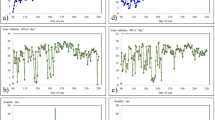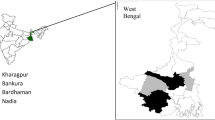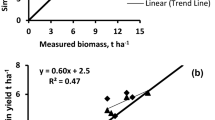Abstract
The objectives of this study were to evaluate the performance of the Cropping System Model (CSM)-CERES (Crop-Environment Resource Synthesis)-Rice for simulating growth and yield of rice under irrigated conditions for a semiarid environment in Pakistan and to determine the impact of plant density and irrigation regime on grain yield and economic returns. The crop simulation model was evaluated with experimental data collected in 2000 and 2001 in Faisalabad, Punjab, Pakistan. The experiment utilized a randomized complete block design with three replications and included three plant densities (one seedling hill−1, PD1; two seedlings hill−1, PD2; and three seedlings hill−1, PD3) and five irrigation regimes (625 mm, I1; 775 mm, I2; 925 mm, I3; 1075 mm, I4; and 1225 mm, I5). To determine the most appropriate combination of plant densities and irrigation regimes, four plant densities from one seedling hill−1 to four seedlings hill−1 and 17 irrigation regimes ranging from 0 to 1600 mm, for a total of 68 different scenarios, were simulated for 35 years of historical daily weather data. The evaluation of CSM-CERES-Rice showed that the model was able to accurately simulate growth and yield of rice for irrigated semiarid conditions, with an average error of 11% between simulated and observed grain yield. The results of the biophysical analysis showed that the combination of the two seedlings hill−1 plant density and the 1,300 mm irrigation regime produced the highest yield compared to all other scenarios. Furthermore, the economic analysis through the Mean-Gini Dominance (MGD) also showed the superiority of this treatment compared to the other treatment combinations. The mean monetary return ranged from −47 to 1,265 $ ha−1 among all 68 scenarios. However, to be able to furnish the demand of rice grain for local consumption and to increase export, there is a need to expand this technology among the rice growers of other rice producing areas in Pakistan through extension workers.









Similar content being viewed by others
References
Ahmad S, Hussain A, Ali H, Ashfaq A (2005a) Transplanted fine rice (Oryza sativa L.) productivity as affected by plant density and irrigation regimes. Intl J Agric Biol 7:445–447
Ahmad S, Hussain A, Ali H, Ahmad A (2005b) Grain yield of transplanted rice (Oryza sativa L.) as influenced by plant density and nitrogen fertilization. J Agric Soc Sci 1:212–215
Ahmad S, Zia-ul-Haq M, Ali H, Shad SA, Ahmad A, Maqsood M, Khan MB, Mehmood S, Hussain A (2008) Water and radiation use efficiencies of transplanted rice (Oryza sativa L.) at different plant density and irrigation regimes under semi-arid environment. Pak J Bot 40:199–209
Ahmad S, Ahmad A, Zia-ul-Haq M, Ali H, Khaliq T, Anjum MA, Khan MA, Hussain A, Hoogenboom G (2009a) Resources use efficiency of field grown transplanted rice (Oryza sativa L.) under irrigated semiarid environment. J Food Agric Environ 7:487–492
Ahmad S, Zia-ul-Haq M, Ali H, Ahmad A, Khan MA, Khaliq T, Husnain Z, Hussain A, Hoogenboom G (2009b) Morphological and quality parameters of Oryza sativa L. as affected by population dynamics, nitrogen fertilization and irrigation regimes. Pak J Bot 41:1259–1269
Ahmad S, Ahmad A, Soler CMT, Ali H, Zia-ul-Haq M, Anothai J, Hussain A, Hoogenboom G, Hasanuzzaman M (2011) Application of the CSM-CERES-rice model for evaluation of plant density and nitrogen management of fine transplanted rice for an irrigated semiarid environment. Precision Agric. doi:10.1007/s11119-011-9238-1
Arora VK (2006) Application of a rice growth and water balance model in an irrigated semi-arid subtropical environment. Agric Water Manage 83:51–57
Banterng P, Hoogenboom G, Patannothai A, Singh P, Wani SP, Pathak P, Tongpoonpol S, Atichart S, Srihaban P, Buranaviriyakul S, Jintrawet A, Nguyen TC (2010) Application of the cropping system model (CSM)-CROPGRO-Soybean for determining optimum management strategies for soybean in tropical environments. J Agron Crop Sci 196:231–242
Barker R, Dawe D, Tuong TP, Bhuiyan SI, Guerra LC (1999) The outlook for water resources in the year 2020: challenges for research on water management in rice production. In: Assessment and orientation towards the 21st century. Proceedings of 19th session of the international rice commissions, Food, Agriculture Organization, Cairo, Egypt, 7–9 September 1998, pp 96–109
Borell A, Garside A, Shu FK (1997) Improving efficiency of water for irrigated rice in a semi-arid tropical environment. Field Crops Res 52:231–248
Bouman BAM, Tuong TP (2001) Field water management to save water and increase its productivity in irrigated rice. Agric Water Manage 49:11–30
Bouman BAM, Shaobing P, Xiaoguang Y, Huaqi W (2002) Aerobic rice: challenges and opportunities: the price of water-reducing water requirements in rice production through aerobic system. In: Paper presented at the international rice congress on innovation, impact, and livelihood, International Rice Research Institute, Beijing, September 16–20 (abstract pp 88)
Buccola ST, Subaei A (1984) Mean-Gini analysis, stochastic efficiency and weak risk aversion. Aust J Agric Econ 28:77–86
Cabangon RJ, Tuong TP, Castillo EG, Bao LX, Lu G, Wang GH, Cui L, Bouman BAM, Li Y, Chen C, Wang J (2004) Effect of irrigation method and N-fertilizer management on rice yield, water productivity and nutrient-use efficiencies in typical lowland rice conditions in China. Paddy Water Environ 2:195–206
Cheyglinted S, Ranamukhaarachchi SL, Singh G (2001) Assessment of the CERES-Rice model for rice production in the Central Plain of Thailand. J Agric Sci 137:289–298
Choudhary MR (2008) A text book of irrigation and drainage: practices for agriculture, study aid foundation for excellence (SAFE). Islamabad, Pakistan, pp 32–35
Fawcett RH, Thornton PK (1989) Mean-Gini dominance in decision analysis. IMA J Math Appl Bus Ind 2:309–317
Feng L, Bouman BAM, Toung TP, Cabangon RJ, Li Y, Lu G, Feng Y (2007) Exploring options to grow rice using less water in northern China using a modeling approach I. Field experiments and model evaluation. Agric Water Manage 88:1–13
Geng S, Zhou Y, Zhang M, Smallwood SK (2001) A sustainable agro-ecological solution to water shortage in the North China Plain (Huabei Plain). J Environ Manage 44:345–355
Godwin DC, Singh U (1998) Nitrogen balance and crop response to nitrogen in upland and lowland cropping systems. In: Tsuji GY, Hoogenboom G, Thornton PK (eds) Understanding options for agricultural production. Kluwer Academic, Dordrecht, pp 55–78
GOP (Government of Pakistan) (2007) Economic survey of Pakistan 2006–2007. Finance Division, Economic Advisory Wing, Finance Division, Government of Pakistan, pp 15–33
GOP (Government of Pakistan) (2008) Economic survey of Pakistan 2007–2008. Economic Advisory Wing, Finance Division, Government of Pakistan, pp 17–36
GOP (Government of Pakistan) (2009) Economic survey of Pakistan 2008–2009. Economic Advisory Wing, Finance Division, Government of Pakistan, pp 17–37
Gungula DT, Kling JG, Togun AO (2003) CERES-maize predictions of maize phenology under nitrogen-stressed conditions in Nigeria. Agron J 95:892–899
Hoogenboom G, Jones JW, Wilkens PW, Porter CH, Boote KJ, Hunt LA, Singh U, Lizaso JL, White JW, Uryasev O, Royce FS, Ogoshi R, Gijsman AJ, Tsuji GY (2010) Decision support system for agrotechnology transfer version 4.5 [CD-ROM]. University of Hawaii, Honolulu, Hawaii
IWMI (International Water Management Institute) (2000) IWMI: global water scarcity study. International Water Management Institute Colombo, Sri Lanka
Jintrawet A (1995) A decision support system for rapid assessment of lowland rice-based cropping alternatives in Thailand. Agric Syst 47:245–258
Jones JW, Hoogenboom G, Porter CH, Boote KJ, Batchelor WD, Hunt LA, Wilkens PW, Singh U, Gijsman AJ, Ritchie JT (2003) The DSSAT cropping system model. Eur J Agron 18:235–265
Kato Y, Okami M, Katsura K (2009) Yield potential and water use efficiency of aerobic rice (Oryza sativa L.) in Japan. Field Crops Res 113:328–334
Kropff MJ, Bouma J, Jones JW (2001) Systems approaches for the design of sustainable agro-ecosystems. Agric Syst 70:369–393
Kumar R, Sharma HL (2004) Simulation and validation of CERES-rice (DSSAT) model in north-western Himalayas. Indian J Agric Sci 74:133–137
Kunimitsu Y (2009) Measuring the implicit value of paddy irrigation water: application of RPML model to the contingent choice experiment data in Japan. Paddy Water Environ 7:177–185
Li Y (2001) Research and practice of water saving irrigation for rice in China. In: Barker R, Loeve R, Li Y, Tuong TP (eds) Proceedings of the international workshop on water-saving irrigation for rice, March 23–25, Wuhan, China. International Water Management Institute, Colombo, Sri Lanka, pp 135–144
Lin S, Dittert K, Sattelmacher B (2002) The Ground Cover Rice Production Systems (GCRPS)—a successful new approach to save water and increase nitrogen fertilizer efficiency? In: Bouman BAM, Hengsdijk H, Hardy B, Bindraban PS, Tuong TP, Ladha JK (eds) Water-wise rice production, 8–11 April 2002, LosBanos, Philippines. International Rice Research Institute, Los Banos, Philippines, pp 187–196
Normile D (2008) Reinventing rice to feed the world. Science 321:330–333
Peng S, Bouman B, Visperas RM, Castaneda A, Nie L, Park H (2006) Comparison between aerobic and flooded rice in the tropics: agronomic performance in an eight-season experiment. Field Crops Res 96:252–259
Rashid MH, Alam MM, Khan MAH, Ladha JK (2009) Productivity and resource use of direct-(drum)-seeded and transplanted rice in puddled soils in rice–rice and rice–wheat ecosystems. Field Crops Res 113:274–281
Ritchie JT (1998) Soil water balance and plant stress. In: Tsuji GY, Hoogenboom G, Thornton PK (eds) Understanding options for agricultural production. Kluwer Academic, Dordrecht, pp 41–54
Ritchie JT, Singh U, Godwin DC, Bowen WT (1998) Cereal growth, development and yield. In: Tsuji GY, Hoogenboom G, Thornton PK (eds) Understanding options for agricultural production. Kluwer Academic, Dordrecht, pp 79–98
Ritchie JT, Porter CH, Judge J, Jones JW, Suleiman AA (2009) Extension of an existing model for soil water evaporation and redistribution under high water content conditions. Soil Sci Soc Am J 73:792–801
Sarkar R, Kar S (2006) Evaluation of management strategies for sustainable rice-wheat cropping system, using DSSAT seasonal analysis. J Agric Sci 144:421–434
Soler CMT, Hoogenboom G, Sentelhas PC, Duarte AP (2007a) Growth analysis of maize grown off-season in a subtropical environment under rainfed and irrigated conditions. J Agron Crop Sci 193:247–261
Soler CMT, Sentelhas PC, Hoogenboom G (2007b) Application of the CSM-CERES-Maize model for planting date evaluation and yield forecasting for maize grown off-season in a subtropical environment. Eur J Agron 27:165–177
Soundharajan B, Sudheer KP (2009) Deficit irrigation management for rice using crop growth simulation model in an optimization framework. Paddy Water Environ 7:135–149
St’astna M, Trnka M, Kren J, Dubrovsky M, Zalud Z (2002) Evaluation of the CERES models in different production regions of the Czech Republic. Rostlina Vyroba 48:125–132
Tabbal DF, Bouman BAM, Bhuiyan SI, Sibayan EB, Sattar MA (2002) On-farm strategies for reducing water input in irrigated rice; case studies in the Philippines. Agric Water Manage 56:93–112
Thornton PK, Hoogenboom G (1994) A computer program to analyze single-season crop model outputs. Agron J 86:860–868
Thornton PK, Hoogenboom G, Wilkens PW, Bowen WT (1995) A computer program to analyze multiple-season crop model outputs. Agron J 87:131–136
Thornton PK, Hoogenboom G, Wilkens PW, Jones JW (1998) Seasonal analysis. In: Tsuji GY, Uehara G, Balas S (eds) DSSAT version 3, vol 3–2. University of Hawaii, Honolulu, pp 1–65
Timsina J, Connor DJ (2001) Productivity and management of rice-wheat cropping systems: issues and challenges. Field Crops Res 69:93–132
Timsina J, Humphreys E (2006) Performance of CERES-rice and CERES-wheat models in rice-wheat systems: a review. Agric Sys 90:5–31
Tsuji GY, Jones JW, Hoogenboom G, Hunt LA, Thornton PK (1994) Introduction. In: Tsuji G, Uehara Y, Balas GS (eds) DSSAT v3, Decision support system for agrotechnology transfer, vol 1. University of Hawaii, Honolulu, p 284
Tsuji GY, Hoogenboom G, Thornton PK (1998) Understanding options for agricultural production. Systems approaches for sustainable agricultural development. Kluwer Academic Publishers, Dordrecht
Tuong TP, Bouman BAM (2003) Rice production in water-scarce environments. In: Proceedings of water productivity workshop, 12–14 November 2001, Colombo, Sri Lanka. International Water Management Institute, Colombo, Sri Lanka
Tuong TP, Bouman BAM, Mortimer M (2005) More rice, less water-integrated approaches for increasing water productivity in irrigated rice-based systems in Asia. Plant Prod Sci 8:231–241
Wallach D, Goffinet B (1987) Mean squared error of prediction in models for studying ecological and agronomic systems. Biometrics 43:561–573
Willmott CJ (1982) Some comments on the evaluation of model performance. Bull Am Meteorol Soc 63:1309–1313
Willmott CJ, Akleson GS, Davis RE, Feddema JJ, Klink KM, Legates DR, Odonnell J, Rowe CM (1985) Statistics for the evaluation and comparison of models. J Geophys Res 90:8995–9005
Yang X, Bouman BAM, Wang H, Wang Z, Zhao J, Chen B (2005) Performance of temperate aerobic rice under different water regimes in North China. Agric Water Manage 74:107–122
Zeigler RS, Puckridge DW (1995) Improving sustainable productivity in rice based rainfed lowland systems of South and South-East Asia. GeoJournal 35:307–324
Zwart SJ, Bastiaanssen WGM (2004) Review of measured crop water productivity values for irrigated wheat, rice, cotton and maize. Agric Water Manage 69:115–133
Acknowledgments
The research was supported in part by the Post Doctorate Fellowship Program of the Higher Education Commission (HEC), Islamabad, Pakistan, for the first author of this paper. The author also appreciates the approval of study leave by the administration of Bahauddin Zakariya University (BZU), Multan, Pakistan.
Author information
Authors and Affiliations
Corresponding author
Additional information
Communicated by S. Azam-Ali.
Rights and permissions
About this article
Cite this article
Ahmad, S., Ahmad, A., Ali, H. et al. Application of the CSM-CERES-Rice model for evaluation of plant density and irrigation management of transplanted rice for an irrigated semiarid environment. Irrig Sci 31, 491–506 (2013). https://doi.org/10.1007/s00271-012-0324-6
Received:
Accepted:
Published:
Issue Date:
DOI: https://doi.org/10.1007/s00271-012-0324-6




